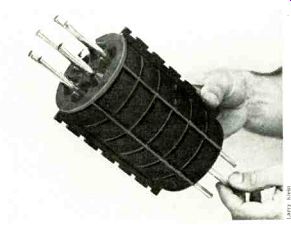By LARRY KLEIN, Technical Editor
If you are wondering whatever happened to the ESS/Heil full-range speaker system. I heard the latest (and possibly final) prototype during a recent visit to ESS in Sacramento. The Heil driver moves air by squeezing it between two adjacent surfaces, rather than pushing and pulling it as all other speakers do.
and the idea is being explored in depth by ESS. I saw perhaps a dozen different configurations of high-frequency drivers in prototype form and, of course, the long awaited full-range system.
In its present incarnation, the low-frequency driver is a long. three-section cylinder installed in a baffle panel so that it can radiate both front and rear. The cylinders house a series of interleaved fixed and moving small (3-inch) dimpled diaphragms, the active ones being driven by a series of rods which are moved by a voice-coil/magnet assembly. The crossover from the Heil tweeter (the same one that's used in the AMT-1) is at 700 Hz.
How did it sound? At least as good as any speaker system I've ever heard. If and when I get a pair of production models to live with for a while, I may have further reactions. I also heard a pair of prototype Heil-device headphones that in an A-B comparison sounded clearly superior to a very well regarded pair of competing Japanese phones previously distributed by ESS. Target date for distribution of the full-range Heil system (in several models) is this fall.
A large West Coast speaker manufacturer/retailer recently spoke despairingly to me about the growing popularity (among the rock freaks) of what he referred to as "thud-squawkers." According to my friend, these are bass-reflex speaker systems designed with a big 70-Hz resonant bump plus an upper mid range peak. Although there is no real 10-W bass response, the resonant peak at 70 Hz provides an illusion of bass. (I sup pose it's better to have a 70-Hz resonance that thuds rather than a 100-Hz resonance that booms.) My friend tells me that because of the competition presented by these units, he's considering designing some bumps and humps into his own smooth-sounding speaker systems. I sympathize with his dilemma; it really hurts when you see the bad speakers outselling the good ones just because so many rock-music listeners have ears, but apparently hear not.
If you're having difficulty finding prerecorded open-reel tapes, you might try Barclay-Crocker. They claim to be the foremost retail specialists in open-reel tapes, carrying the largest selection of titles available anywhere. They offer a fast, efficient, personalized service at discount prices both over the counter and through mail order, and visitors are welcome to stop by their office and browse. All the latest Dolby and quadraphonic open-reel releases are listed in B C's bimonthly newsletter, Reel News. If you would like a subscription to this publication, along with a copy of their comprehensive and very nicely put together new 96-page catalog, send one dollar to: Barclay-Crocker, 11 Broadway, Room 85705R, New York, N.Y. 10004.
Through the unhappy experience of having my apartment broken into, I've discovered a hitherto unrealized virtue of high-power, heavy-duty audio equipment. My speakers, tape deck, and power amplifiers apparently were just too heavy to steal. But (worry, worry) maybe the thieves intend to return later with the required jacks. lifts, dollies, and hand trucks.

--- One of the three cylindrical modules from a prototype Heil
woofer. Diaphragm motion is provided by the lightweight rods seen protruding
from the ends, and air is "squeezed" out of the slots in the housing.
The magnet/voice-coil assembly that drives the rods is part of the top and
bottom modules.
==============
Also see:
TAPE HORIZONS: Microphone Types, CRAIG STARK